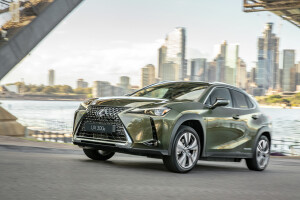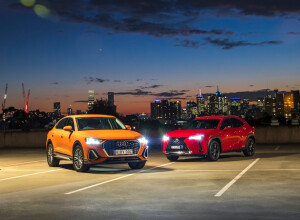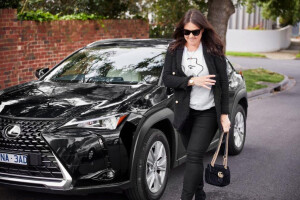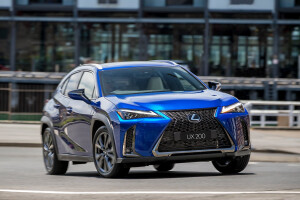Latest Review

Lexus UX300e vs Volvo XC40 Electric comparison review
This pair square up on price, but all is not equal when Japan takes on Sweden for dominance in the compact electric SUV segment
It’s tricky to pinpoint exactly when the world’s luxury car brands hit their respective panic buttons, upon realising the Tesla-inspired and emissions-influenced electric-car revival was neither another GM EV1 moment nor an industry anomaly.
Audi, BMW and Mercedes are all just about on an EV roll in the catch-up game, yet only now are we seeing the first battery vehicles from Lexus and Volvo.
The lateness of an electric Lexus is particularly surprising when you consider its parent company pioneered hybrid technology more than two decades ago.
Electrification seems a natural fit for a brand as wholesome as Volvo, too, and the Swedish company, after stating in 2017 it would offer a mix of variously electrified vehicles from 2025, has since declared all its cars will be fully electric from 2030. Lexus has even more recently stated its intention to adopt the same strategy from 2035.
Their battery-powered debutants – the Lexus UX300e and Volvo XC40 Recharge Pure Electric – couldn’t be much closer in concept: compact luxury SUVs just under 4.5 metres in length; built on adapted platforms designed to initially accommodate petrol and hybrid drivetrains; fastest models in their respective ranges; flagships priced in the mid-$70,000 zone.
And each is differentiated visually from its petrol or hybrid siblings in subtle ways. Main giveaways are the ‘Electric’ badging applied to the UX300e’s doors, and the slab of plastic slotted into the spot where the XC40’s conventional grille usually sits.
Our high-specification, dual-motor XC40 Pure Electric was priced from $76,990 when tested, before an MY22 increase to $79,990 was announced in late December. This was accompanied by confirmation of an incoming single-motor variant that will cost $72,990 before on-road charges.
Lexus’s entry-grade UX300e Luxury starts at $74,000. That’s an important figure for NSW buyers because, unlike the revised Volvo price, it qualifies the Japanese SUV for stamp-duty reimbursement of about $3000 by sitting below the state’s $78,000 threshold. However, eight of the Lexus’s 10 exterior paints cost an extra $1750, where all Volvo colours are inclusive.
The XC40’s equipment list is also longer, with key upper-hands including a panoramic sunroof, surround-view camera, full-size digital driver display, and voice control. There’s also 20-inch wheels compared with 17s for the Lexus.
MY22 Pure Electric dual-motor versions will add pixel headlights with 84 individually controlled LEDs, though also ditch the current leather-accented seats for fabric upholstery – putting it on a vegan-friendly par with the UX300e Luxury that’s trimmed in artificial leather.
One-ups for the Lexus are limited to electric steering wheel adjustment and ventilated front seats. Upgrading to the $81,000 UX300e Sports Luxury gains genuine leather upholstery, 18-inch wheels, 360-degree camera, smarter LED headlights, head-up display, moonroof, and some higher-grade interior finishes.
Regardless of grade, Lexus throws in an extensive ownership package. Besides becoming the first Lexus to benefit from a factory warranty that lengthens from four to five years (matching Volvo), the UX300e comes with three years of complimentary charging via the Chargefox network, a free 7kW AC home wall charger, and three years of Lexus Encore Platinum membership that includes perks such as free loan vehicles (if limited to four occasions).
A 10-year/unlimited-km battery warranty is also longer than Volvo’s 8-year/160,000km backing (Lexus just stipulates annual battery checks after five years).
Servicing is Volvo’s main owner bonus – inclusive for three years/100,000km where Lexus charges $295 annually or every 15,000km – while it offers eight years of roadside assistance to Lexus’s five.
The Swedes also throw in a four-year subscription to a Digital Services package, which via an embedded e-sim delivers online services to Volvo’s new-generation, Android-based infotainment system that was co-developed with Google.
Advantage Volvo overall in our book, and that’s before factoring in the XC40 Pure Electric’s decisive technical edge.
Punching out 300kW/660Nm from its electric motors and providing a WLTP-rated range of up to 418km from its 78kWh battery, it leaves the Lexus looking like it belongs to a lower tier.
The front-drive UX300e serves up 150kW and 300Nm from its solitary motor, while the range from its 54.3kWh battery maxes out at a relatively short 305-315km. (No wonder Lexus Australia, somewhat disingenuously, quotes only the older-cycle NEDC figure of 360km.)
At full charge, each EV indicated an estimated real-world range below those lab figures (as is common): 350km for the Volvo and 267km for the Lexus.
Plentiful range for weekday commuting and school runs, especially with home charging, though to test weekend-excursion credentials we set off for the countryside. Our destination sticks to the theme of sustainable compact luxury: one of those tiny, rentable off-grid eco houses popping up all over regional Australia.
‘Edmond’ lies just under 130km from our starting suburb in Sydney, making for a return trip that should be easily manageable for the Volvo but will task the Lexus with getting closer to its WLTP-rated range.
An immediate difference when getting underway: a starter button needs to be pressed to switch on the Lexus; in the Volvo you simply flick the gearlever into Drive.
Lexus’s front seats may be finished in artificial leather but they’re tactile, look posh, are supple and comfortable – you sink straight into them. They’re relatively low slung compared with the XC40’s seats.
Pampering is extended by the UX300e’s generally graceful low-speed ride, delivered by a combination of long-stroke suspension, small wheels, and chubby tyres. Only potholes and repair joins upset composure, with the bigger-wheeled XC40 surprisingly better at absorbing bigger hits.
The Volvo’s ride is noticeably stiffer, though – a consequence of its 20-inch rims and spring/damper rates that have been increased to compensate for the Pure Electric’s heavy battery components. There’s also unexpectedly sporty rubber. The Pirelli P Zeros generate more noise than the Lexus’s bespoke EV tyres, which are further insulated from the cabin with wheelarch liners.
The tables are turned slightly on the freeway, where the XC40’s suspension exhibits a more pliable nature while the UX’s dampers continue to inform you of larger bumps the Volvo’s ignore.
Wind noise is also more evident in the Lexus despite its acoustic-glass windscreen; and the chubby steering wheel isn’t as precise as the Volvo’s around the straight-ahead.
Volvo quotes 4.9sec for the twin-motor XC40’s 0-100km/h time – acceleration that puts this family EV in Golf R territory. It’s potent performance that forces your torso into the seatback under full throttle.
The regenerative braking is also quite forceful when One-Pedal Mode is activated. Most testers preferred to switch it off and instead rely on the brake pedal, which is wooden in feel but easier to modulate than the left pedal in the hybrid XC40.
Move the Lexus’s gearlever from D to B (Braking) and paddleshift levers can be flicked to alter the regen effect through four levels, though even in the highest setting the deceleration is quite weak when lifting off the throttle.
The brake pedal is always needed to bring the UX300e to a stop, a process made abrupt in the last part of travel by a slightly clumsy transition from regen to hydraulic braking.
A 7.5-second sprint time for the Lexus looks like a spectacular capitulation on paper, but it feels quicker than that. The electric motor’s ultra-smooth delivery and hushed operation also establishes it as the most natural drivetrain for a brand that used refinement to put itself on the automotive map.
Uncouthly behaviour awaits in wet conditions, however, when even a modest squeeze of the throttle overwhelms the UX300e’s Dunlop Enasave eco tyres, sending the traction control warning symbol into a frenzy of flashing.
There’s also torque steer to contend with, further dulling our enthusiasm for exploring the UX300e’s promise of offering the lowest centre of gravity in the UX range and an 1840kg kerb weight that’s relatively light in an EV context.
The Volvo’s agility is blunted by its 2158kg bulk, yet a collaboration of reasonably taut body control, all-wheel drive and wide (255mm) rear rubber contrives a confident, planted feel in corners. The Swedish EV also gets a second opportunity to prove that two motors – one per axle – is better than one, when tasked with climbing the wet, grassy hill atop of which sits our eco ‘house’. Where the XC40 breezes up first time, the UX spins its front wheels to failure twice before a third attempt – using a much longer run up – succeeds in the name of momentum.
‘Edmond’ packs a loft bedroom, lounge/dining area, kitchen, and bathroom into a dwelling that occupies a footprint smaller than your average garden shed, if taller. Power comes courtesy of solar panels and gas bottles. Water comes from a rain tank.
It’s a marvel of packaging efficiency the XC40 can respect. The compact SUV’s cabin will accommodate a quartet of six-footers without asking the rear passengers to become uncomfortably acquainted with seatbacks or headlining.
Transmission tunnels betray the absence of bespoke electric platforms here, ruling out the middle seat as a comfortable spot for adults.
The Lexus is the slightly longer vehicle, yet access through its rear doors is narrow and there’s less legroom inside. Toe space is almost nonexistent. Space above is less of an issue despite the stepped battery pack design lifting the electric UX’s rear hip point by 16mm.
Lexus Australia quotes 414 litres for the UX300e’s boot capacity, making it the largest in the range. Yet it’s trumped by the XC40’s 452-litre compartment. The Volvo’s boot also looks bigger and provides extra-practical features such as a ski port and a fold-up floor divider with bag hooks. Both SUVs offers some underfloor storage, restricting puncture-remedy duties to a repair kit.
A 31-litre ‘frunk’ makes the Pure Electric the most practical XC40, a useful extra space large enough to stow a medium-sized holdall. The Lexus’s ‘engine’ bay is instead brimmed with complex plumbing and various components including the electric motor.
Still assembled in the middle of a muddy field, we need to get back on the grid. With just 92km left on the UX300e’s readout after some photography manoeuvres, a detour to a charging station in Mittagong is now mandatory.
No worries for the Volvo, which still has 180km available.
Curiously, and unlike its Polestar 2 twin, the XC40 Pure Electric doesn’t provide a constant distance guide in its driver display. It appears only once battery life has dropped to 20 percent and below. Owners can instead access a Range Assistant app in the central nfotainment screen, which provides estimated kilometres along with real-time energy consumption, energy-usage guide, and a climate-adjusting Range Optimiser function.
The app can be overly pessimistic, gradually correcting via its regular recalibration to confirm our wider experience that a fully charged electric XC40 should deliver more than 360km, if needing all variables in its favour to reach 400km.
The UX300e’s battery-range estimates were impressively accurate, though even with superior energy efficiency – hitting as low as 18.3kWh per 100km compared with a 20.7kWh/100km best for the Volvo – the smaller-battery Lexus never suggested it could achieve a 300km range.
DC fast-charging capability is also limited to 50kW where it’s up to 150kW for the Volvo, and the Lexus uses an older-school CHAdeMO plug (with a separate AC charging port on the opposite flank) rather than the more universal CCS Type 2 used by the XC40.
Not that this made a difference at the Mittagong station with its 50kW cap and both plug types.
Plotting the nav-course home, the Volvo reveals further advantages. Aside from the beautiful simplicity of Google Maps incorporated into an infotainment system also featuring Google Assistant, the XC40’s route display handily predicts end-of-journey battery life.
The Pure Electric’s driver display, as in other XC40s, can also be switched to a map mode, freeing up the infotainment screen for other functions.
Lexus’s smaller, TFT driver display looks a couple of generations behind, as do the graphics of its infotainment screen. Combined with a laptop-style trackpad that can make function selections a fiddly process, the awkward interaction and below-par interface couldn’t be more ironic for a car badged UX (a common abbreviation for ‘user experience’ among app and website developers).
Volvo’s system isn’t perfect yet, with some issues being ironed out locally. Both our comparison car and another XC40 we had in Melbourne were afflicted by intermittent connectivity struggles and response lag. The radio also had a frustrating habit of switching off whenever a settings page was selected.
The XC40 Pure Electric will continue to be improved with automatic over-the-air updates, including further developments for the Range Assistant app (including distance-maximising coaching for drivers) that was itself a post-launch addition. No improvements are necessary to alter the result here, however.
The UX300e seems out of its depth at this price point. Its restrictive cabin significantly reduces its viability as a family vehicle, and its relatively limited range will rule it out for many single-car households.
Accept these compromises and the UX300e’s generally relaxing ride and smooth, silent electric motor make for the quintessential Lexus motoring experience. It’s also a vehicle that maintains, if not furthers, the Japanese brand’s reputation for customer care.
The XC40 Pure Electric’s efficiency could be better, its low-speed ride is firmer than ideal, and its regenerative braking system should offer greater level of adjustment.
But whether there’s urgent need for more interior space, more places to stash stuff, more performance or, most crucially, more range, the Volvo is the EV less likely to leave its owners feeling panicky.
Lexus UX300e interior details
1. Fuel-style battery gauge
Estimated driving range presented in digital form only, with the battery-life percentage represented by a gauge featuring a bowser symbol – but with a plug lead rather than fuel nozzle.
2. Climate management
Cabin-climate system works with the battery pack’s cooling system to help prolong battery life. If only the driver is detected on board, the dual-zone system automatically ignores the front passenger area.
3. Drive modes
As in other UX variants, stubby switches jut out of each side of the instrument binnacle. The left switch accesses Eco, Normal and Sport drive modes, with the latter bringing some extra response to acceleration and extra weight to the steering.
Volvo XC40 interior details
1. Innovative storage
Pure Electric shares clever cabin practicality of other XC40s, with features such as pull-out glovebox hook, removable centre console tub, and super-long door pockets that can accommodate large items such as laptops and umbrellas.
2. ‘Gear’ lever
Unlike other XC40s, the EV bypasses neutral so no need to double pull or push to select Drive/Reverse.
3. Portrait touchscreen
9.0-inch display is smaller than the 11.2-inch version found in the twin Polestar 2. Its Google-based system does have some glitches, but may be resolved with over-the-air (OTA) updates.
The next EV agendas from Lexus and Volvo
The next confirmed Lexus EV is the RZ450e, due to be unveiled in the first half of 2022. The RZ shares the e-TNGA platform with the Toyota b24X and, according to a senior Lexus executive, will deliver a circa-700km range and sub-2.0sec 0-100km/h acceleration.
Volvo, meanwhile, already has a second EV of sorts available in Australia – the Polestar 2 sedan from its spin-off brand. In late 2022, Volvo will add a coupe-roofed XC40 called the C40 Recharge while also unveiling a third-generation XC90 that will be all-electric and adopt a new name.
Mercedes EQA and Audi Q4 e-tron
The Germans itching to get in the mix
Mercedes-Benz’s $76,800 EQA250 would have fitted neatly into this comparison, though is currently unavailable for testing. The front-drive, GLA-based EV is slower than either the Lexus or Volvo with a 0-100km/h time of 8.9 seconds, but it also offers a longer range of up to 480km. From early 2022, customers will have the option to sacrifice some range for more speed with the all-wheel drive EQA350 4Matic.
Audi also has the potential to jump into the mix with its Q4 e-tron, with its arrival yet to be confirmed. The Q4 sits on the VW Group’s MEB electric platform and in Europe is offered in a variety of specifications including choice of battery size.
SCORING
Volvo XC40 Pure Electric: 8/10
Lexus UX300e Luxury: 7/10
News
-
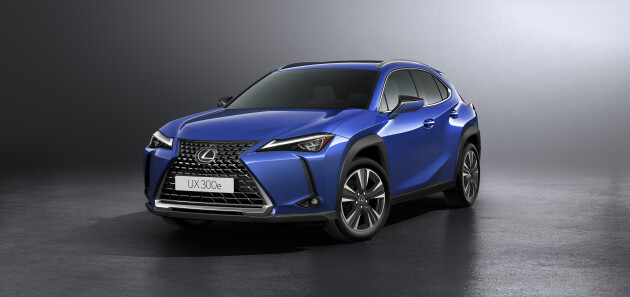 News
News2023 Lexus UX 300e update inbound with bigger battery and greater driving range
Lexus's updated electric UX is coming to Australia with a bigger battery, greater driving range and new tech
-
 News
News2023 Lexus UX pricing and features for Australia
Updated Lexus UX to land from September with increased tech and features
-
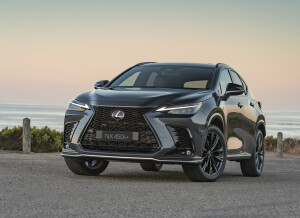 News
NewsLexus records hybrid and electric sales growth in Australia
The brand’s electrified options have accounted for nearly half of its sales in Australia to July 31, a significant jump from the same time last year
-
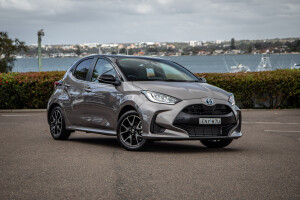 News
NewsAustralia's most fuel-efficient cars in 2022
Here's every car without a plug, on sale now, that sips five litres per 100km – or less
-

2023 Lexus UX update revealed, Australian launch confirmed
-

2015-2021 Lexus RX and UX models recalled over ADR compliance issue
-
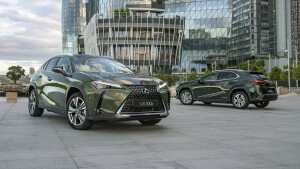
2022 Lexus UX300e pricing announced, and Lexus increases warranty to 5 years
-

Lexus UX300e to come with free 7kW home charger



